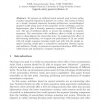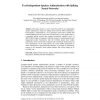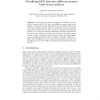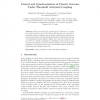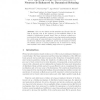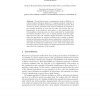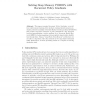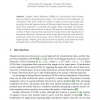110
click to vote
ICANN
2007
Springer
15 years 4 months ago
2007
Springer
We present an artificial neural network used to learn online complex temporal sequences of gestures to a robot. The system is based on a simple temporal sequences learning architec...
121
Voted
ICANN
2007
Springer
15 years 4 months ago
2007
Springer
Abstract. Trained support vector machines (SVMs) have a slow runtime classification speed if the classification problem is noisy and the sample data set is large. Approximating the...
107
Voted
ICANN
2007
Springer
15 years 4 months ago
2007
Springer
This paper presents a novel system that performs text-independent speaker authentication using new spiking neural network (SNN) architectures. Each speaker is represented by a set ...
104
click to vote
ICANN
2007
Springer
15 years 4 months ago
2007
Springer
In this paper, we discuss fuzzy classifiers based on Kernel Discriminant Analysis (KDA) for two-class problems. In our method, first we employ KDA to the given training data and ca...
101
click to vote
ICANN
2007
Springer
15 years 4 months ago
2007
Springer
Abstract. In this paper we consider the question of whether it is possible to classify n-back EEG data into different memory loads across subjects. To capture relevant information ...
ICANN
2007
Springer
15 years 7 months ago
2007
Springer
Abstract. We have studied the spatiotemporal behaviour of threshold coupled chaotic neurons. We observe that the chaos is controlled by threshold activated coupling, and the system...
ICANN
2007
Springer
15 years 7 months ago
2007
Springer
Abstract. How can two distant neural assemblies synchronize their firings at zero-lag even in the presence of non-negligible delays in the transfer of information between them? He...
114
click to vote
ICANN
2007
Springer
15 years 7 months ago
2007
Springer
Abstract. This article presents a comprehensive study of different ensemble pruning techniques applied to a bagging ensemble composed of decision stumps. Six different ensemble p...
ICANN
2007
Springer
15 years 7 months ago
2007
Springer
Abstract. This paper presents Recurrent Policy Gradients, a modelfree reinforcement learning (RL) method creating limited-memory stochastic policies for partially observable Markov...
85
Voted
ICANN
2007
Springer
15 years 7 months ago
2007
Springer
Support Vector Machines (SVMs) for classification tasks produce sparse models by maximizing the margin. Two limitations of this technique are considered in this work: firstly, th...
